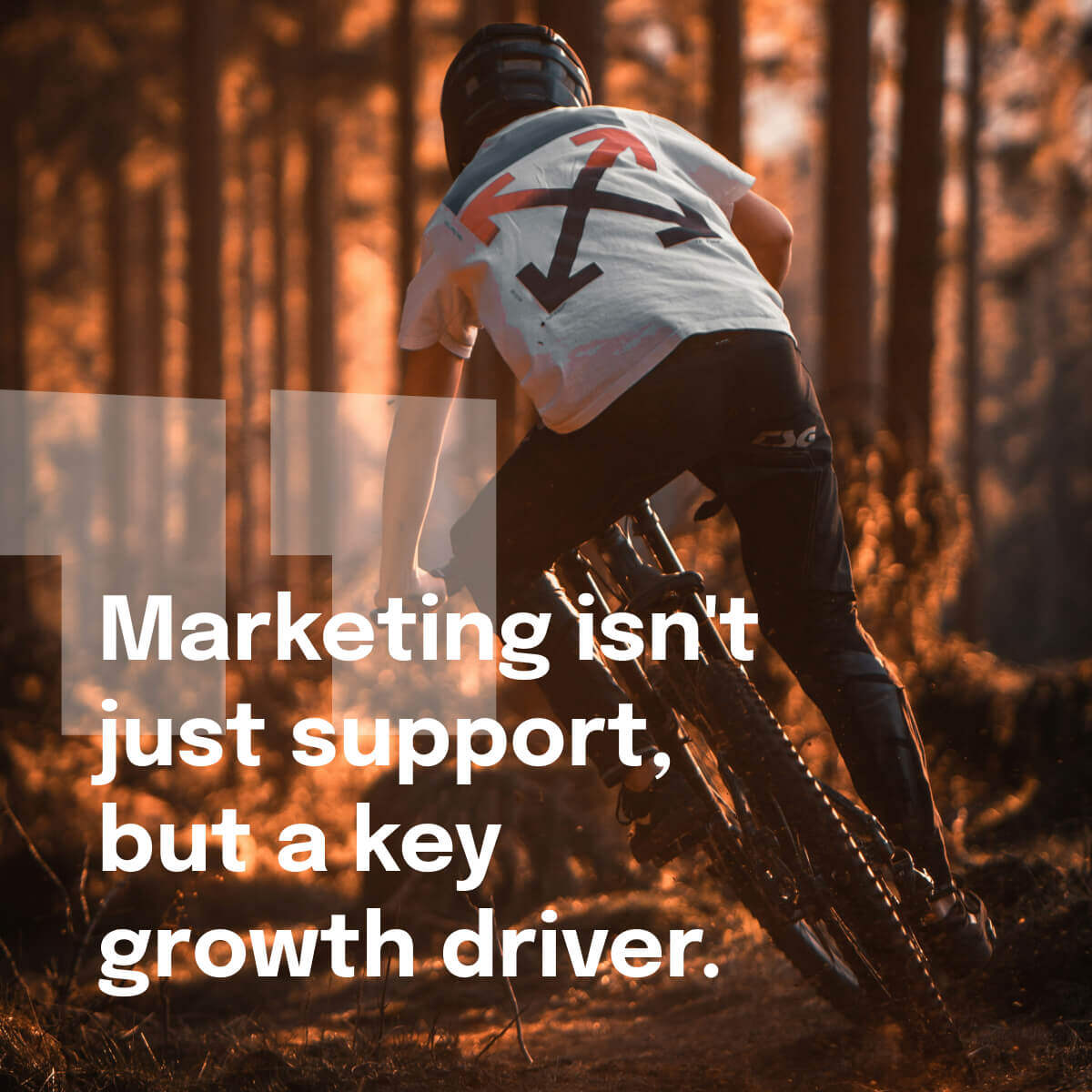The B2B commercial function is undergoing a profound transformation, driven by shifts in buyer behaviour, advancements in technology, and the changing expectations of a digitally native workforce. As we look towards the future, several key trends are shaping the way commercial functions operate.

1. Digital natives redefining decision-making
The ascent of digital natives into decision-making roles is redefining the dynamics of the commercial function. Millennials, with their preference for digital interactions and data-driven decision-making, are ushering in a new era where commercial strategies need to be agile, tech-savvy, and tailored to resonate with this influential demographic. The commercial function must adapt by embracing digital channels, personalised engagement, and leveraging technology to align with the preferences of these decision-makers.
2. Seamless journeys: the online odyssey from start to finish
The buying journey in B2B commerce is shifting towards a predominantly online experience, with seamless transitions between online and offline interactions. The commercial function must reimagine its approach to cater to customers who initiate and conclude their purchasing decisions in the digital realm. This involves optimising online platforms, enhancing user experiences, and integrating digital touchpoints throughout the customer journey to ensure a cohesive and engaging buying experience.
3. B2B eCommerce boom: unveiling projections for a $2.5 trillion landscape
The significant growth projected for B2B eCommerce, expected to reach $2.5 trillion in the US by 2026, underscores the necessity for the commercial function to embrace digital platforms fully. This entails optimising eCommerce strategies, investing in user-friendly interfaces, and utilising data-driven insights to enhance the online buying experience. The commercial function's role expands beyond traditional sales to encompass a holistic approach that leverages the power of digital channels.
4. Building trust in a saturated market: thought leadership and creativity
As the market becomes saturated with information, building trust in B2B relationships becomes a pivotal aspect of the commercial function. Thought leadership, coupled with creative storytelling, emerges as a cornerstone in establishing trust. Commercial teams must collaborate with marketing to position their brand as a thought leader, providing valuable insights and innovative solutions that resonate with customers and differentiate the brand in a competitive landscape.
5. AI's creative revolution: transforming content production in B2B
Artificial Intelligence is revolutionising content creation and creativity, enabling cost-effective, large-scale, and rapid production. The commercial function must harness the power of AI to enhance its communication strategies, personalise content at scale, and deliver impactful messaging. Collaboration with marketing becomes crucial to align AI-driven creativity with overarching brand strategies, ensuring a cohesive and compelling narrative that resonates with the target audience.
Watch the event recording of The future of B2B commerce!
6. Data-driven decision-making: enhancing B2B experiences with variety
The increase in data and metadata variety presents an opportunity for the commercial function to enhance decision-making and orchestrate B2B experiences. By leveraging data collaboratively with other departments, commercial teams can gain deeper insights into customer behaviour, refine their targeting strategies, and optimise the overall customer experience. This data-driven collaboration ensures a more precise and effective approach to meeting customer needs.
7. Tech-stack synergy: maximizing martech, sales enablement, and adtech ROI
Improved utilisation of the tech stack across the commercial function is essential for maximising ROI in martech, sales enablement, and adtech. Collaboration with other departments, particularly marketing, is critical to ensure seamless integration and alignment of technologies. This collaborative effort enhances efficiency, data management, and the overall effectiveness of commercial strategies, providing a competitive edge in the fast-paced B2B landscape.
8. Holistic go-to-market strategy
The future of go-to-market (GTM) strategy and function in B2B commerce demands a holistic approach that transcends traditional silos. As the lines between marketing, sales, and customer success continue to blur, successful organisations will prioritise an integrated GTM strategy. This collaboration ensures a seamless customer journey from initial awareness through acquisition, retention, and advocacy.
The customer experience will be at the forefront, and GTM strategies will focus on delivering cohesive and personalised interactions at every touchpoint. This holistic approach will optimise resources, eliminate redundancies, and enhance overall efficiency, allowing businesses to adapt quickly to evolving market dynamics. The convergence of marketing, sales, and customer success under a unified GTM strategy will be pivotal in navigating the complexities of B2B commerce and cultivating long-term customer relationships.
9. The era of hybrid selling: blurring lines between virtual and in-person interactions
In the future landscape of B2B commerce, the traditional demarcation between inside sales and field sales is giving way to the rise of hybrid selling models. The convergence of digital channels and in-person interactions marks a paradigm shift in how businesses approach their sales strategies.
Hybrid selling combines the strengths of both virtual and face-to-face interactions, acknowledging the diverse preferences of modern buyers. Sales teams will leverage advanced communication technologies, virtual meetings, and AI-driven insights to engage with clients online while still recognising the value of in-person interactions for relationship-building and complex negotiations.
This approach requires a dynamic and adaptable sales force capable of seamlessly transitioning between virtual and physical environments. Collaborative efforts between sales and marketing will be essential to align messaging, optimise digital platforms, and create personalised experiences that resonate across both fields.
10. Elevating B2B relationships through empathy and human touch
As B2B commerce continues its digital evolution, the importance of empathy and a human touch in business relationships is poised to become a defining factor in successful go-to-market strategies. The future of the commercial function will emphasise the human side of transactions, recognising that behind every business decision is a person seeking understanding, connection, and value.
In an era where automation and AI streamline processes, the ability to infuse empathy into interactions will set businesses apart. Commercial functions will prioritise cultivating a deeper understanding of clients' needs, challenges, and aspirations. This understanding will guide not only the development of personalised solutions but also the delivery of messages that resonate on a human level.
Collaboration between sales, marketing, and customer success will be instrumental in crafting and communicating a brand narrative that reflects genuine empathy. Marketing will play a significant role in creating content that speaks to the human experience, while sales and customer success teams will leverage this content to build authentic connections throughout the customer journey.
Whether through personalised communication, thoughtful engagement strategies, or responsive customer support, the human touch will remain a cornerstone of B2B relationships. Organisations that prioritise empathy in their go-to-market strategy will forge lasting connections, foster loyalty, and stand out in an increasingly digital landscape, where authenticity and understanding are the keys to building enduring business partnerships.
Conclusion
These ten key trends show a path forward characterised by adaptability, innovation, and a profound understanding of human connection. From the influence of digital natives shaping decision-making to the convergence of online and offline interactions, the commercial function is embracing a holistic transformation.
Trust-building, driven by thought leadership and creativity, is paramount in navigating a saturated market, while AI revolutionises content creation. The era of hybrid selling acknowledges diverse buyer preferences, blending virtual and in-person interactions. Amidst automation, the human touch emerges as indispensable, fostering lasting connections. The future of go-to-market strategies emphasises a seamless customer journey, breaking down traditional silos.
Success in B2B lies not merely in transactions but in orchestrating a symphony of interactions tailored to the digital-savvy audience – a future where businesses embracing innovation, collaboration, and human-centricity will not just thrive but lead the way.
As Max Nyman, VP, Enterprise Business at Valve, says: "These trends are not just predictions for the future; they are realities that we encounter every day in our client projects. We are witnessing a paradigm shift in B2B, where digital transformation, customer-centricity, and human connection are the driving forces. To succeed in this new era, we need to embrace these trends and leverage them to create value for our customers and partners."
References:
Winterberry Group 2023: OUTLOOK FOR B2B MARKETING A MARKET IN TRANSFORMATION



